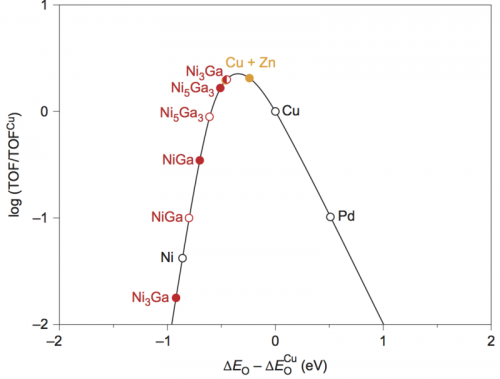Theoretical activity volcano for CO2 hydrogenation to methanol. Turnover frequency (TOF) is plotted as a function of ∆EO, relative to Cu(211). ∆EO for the stepped 211 surfaces of copper, nickel and palladium is depicted as open black circles, and Cu+Zn is depicted in orange. ∆EO for Ni-Ga inter metallic compounds is depicted in red. Closed circles indicate nickel-rich sites, open circles gallium-rich sites and half-open circles mixed sites. Reaction conditions are 500 K, 1 bar, and a CO2:H2 ratio of 1:3.
The use of methanol as a fuel and chemical feedstock could become very important in the development of a more sustainable society if methanol could be efficiently obtained from the direct reduction of CO2 using solar-generated hydrogen. If hydrogen production is to be distributed, small-scale CO2 reduction devices are required that operate at low pressures. Now, a Ni-Ga catalyst that reduces CO2 to methanol at ambient pressure was identified through a descriptor-based analysis of the process. The use of computational methods allowed for the identification of Ni-Ga intermetallic compounds as stable candidates with good activity (see Figure). Subsequent synthesis and testing of a series of catalysts identified Ni5Ga3 as being particularly active and selective. Comparison with conventional Cu/ZnO/Al2O3 catalysts reveals the same or better methanol synthesis activity, as well as considerably lower production of CO. The discovery of Ni5Ga3 marks a first step towards the development of small-scale low-pressure devices for CO2 reduction to methanol.

